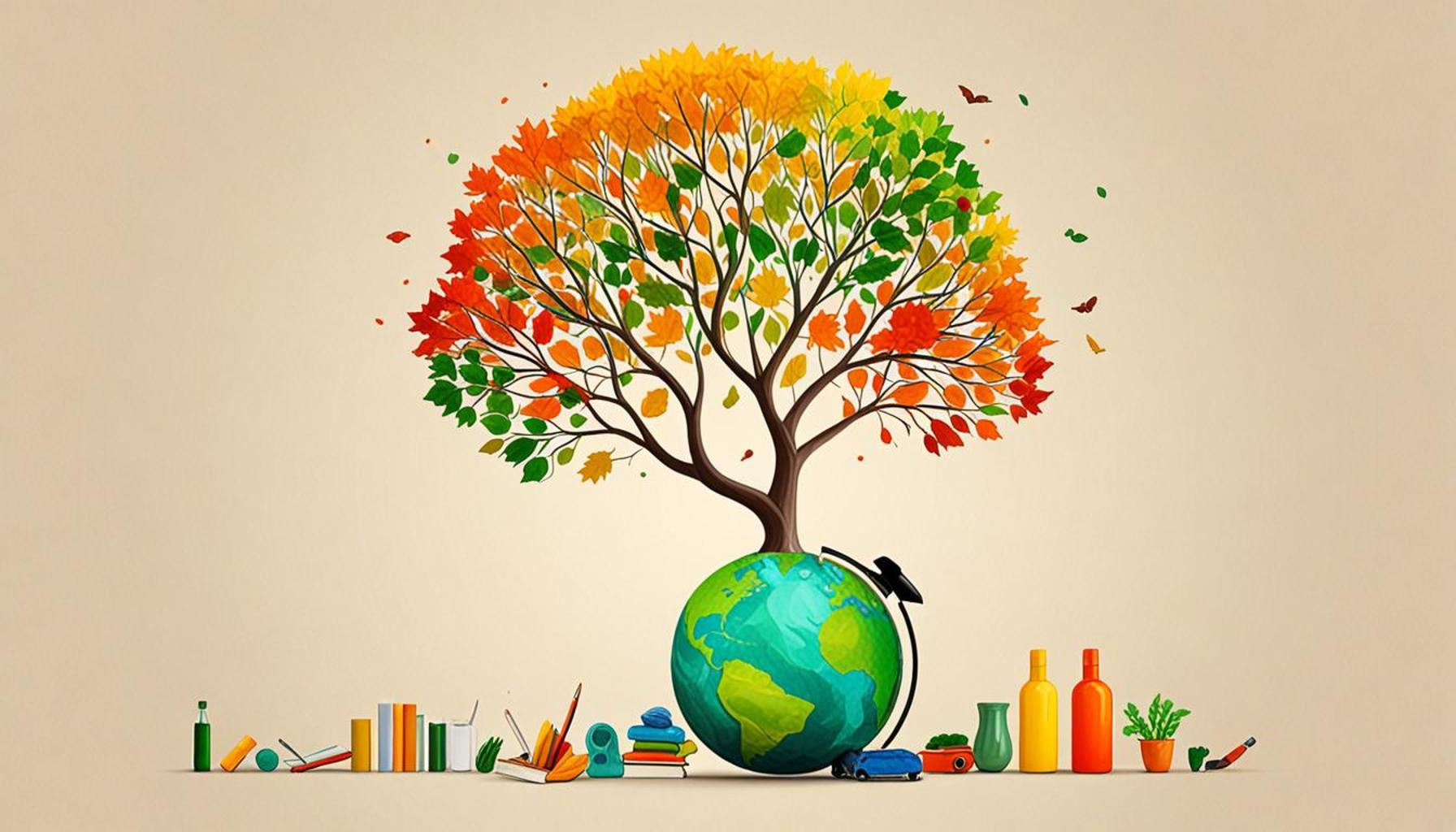The Art of Letting Go: Decluttering Techniques Inspired by Cultures Around the World

The Importance of Decluttering
In our fast-paced lives, holding onto possessions can feel comforting. However, the art of letting go not only frees physical space but also opens up emotional and mental clarity. A cluttered environment can create stress and hinder creativity, whereas a tidy space fosters feelings of peace and control. By embracing decluttering, you create a sanctuary that allows for greater focus on what truly matters in life. Different cultures across the globe offer unique methods and philosophies on decluttering that may inspire you to embark on your own journey of simplification.
Global Perspectives on Decluttering
Many societies have embraced the idea of minimalism in their own distinct ways, reflecting both practical and spiritual approaches to organizing personal spaces. Here are a few notable examples that exemplify this notion:
- Japanese KonMari Method: Developed by Marie Kondo, this method encourages individuals to keep only items that “spark joy.” The process involves a meticulous category-by-category decluttering, where each item is thoughtfully considered for its emotional value. This practice emphasizes a shift from quantity to quality, cultivating a deeper appreciation for one’s possessions.
- Swedish Death Cleaning: In Sweden, this practice involves decluttering one’s possessions before death, thereby alleviating the burden on loved ones. This poignant approach to life and death urges individuals to make mindful decisions about what personal items they wish to leave behind, ensuring that those they care about are not overwhelmed by excess belongings during a difficult time.
- Indian Vastu Shastra: Rooted in ancient Hindu architecture, Vastu Shastra promotes organizing spaces to allow positive energy flow. This philosophy underscores the belief that clutter not only impacts physical space but also influences emotional well-being and harmony within the home. Fostering an environment that resonates with tranquility is therefore pivotal in Indian culture.
Decluttering in Nigeria
In Nigeria, influenced by both traditional values and modern living, the act of letting go can be a transformative process enriched by communal ties. Many individuals engage in various forms of decluttering that reflect the cultural significance of space and possessions:
- Seasonal clean-ups: This practice typically coincides with cultural festivals like Christmas. During these times, families come together to declutter their homes, preparing to welcome new items and guests. It is not just about cleaning; it represents a renewal and a fresh start, embodying the spirit of giving and hospitality prevalent during festive seasons.
- Community swaps: In many Nigerian neighborhoods, community swap events enable neighbors to exchange items instead of discarding them. This approach fosters a sense of community and sustainability, reducing waste while providing an opportunity for individuals to acquire items they may need without spending money. These exchanges often become social gatherings, strengthening community bonds.
By exploring these unconventional decluttering techniques, we invite you to embark on a journey toward simplicity. Adopting elements from diverse cultures can enhance your own practice of letting go, creating a more organized and meaningful life. Whether you resonate with the joy-sparking practices of the Japanese or the communal influences of Nigerian traditions, there lies a wealth of wisdom to be discovered in the art of decluttering. It encourages introspection, rejuvenation, and a renewed connection to one’s surroundings, inviting you to take the first step towards a decluttered and purposeful existence.
CHECK OUT: Click here to explore more

Exploring Cultural Approaches to Decluttering
As we navigate the complexities of our modern lives, the concept of letting go takes on various forms across different cultures. Each unique method not only offers practical advice but also imparts valuable life lessons that resonate at a deeper level. By understanding and incorporating these global perspectives, we can find a more meaningful approach to decluttering that transcends mere organization.
The Minimalist Zen of Japan
In Japan, the art of decluttering is intricately tied to the cultural philosophy of minimalism and mindfulness. The KonMari Method, popularized by Marie Kondo, champions a radical approach to organization. Participants engage in a thorough evaluation of personal belongings, asking themselves whether each object “sparks joy.” This method transcends physical decluttering; it promotes emotional growth and self-reflection that can shift perceptions about materialism.
- Category-by-Category Approach: Rather than decluttering room by room, the KonMari Method focuses on specific categories such as clothing, books, and sentimental items, providing a systematic way of assessing the importance of our belongings.
- Emotional Engagement: By connecting with the memories tied to each item, individuals are encouraged to appreciate their past while making room for their future.
This method not only creates a serene space but also encourages Japanese households to embrace the philosophy of “less is more,” reflecting a broader societal commitment to simplicity and elegance.
Sweden’s Reflective Approach to Decluttering
In Sweden, the concept of death cleaning, or *Dostadning*, profoundly influences how individuals manage their possessions. This practice involves clearing out unnecessary belongings with an awareness of one’s mortality. It emphasizes a proactive approach where individuals can thoughtfully pass on cherished items to loved ones before they enter old age. As a result, this practice encourages a culture of care and thoughtfulness:
- Legacy Consideration: By evaluating what should be kept and what ought to be discarded, individuals engage in deep conversations with family members, fostering emotional connections and shared memories.
- Practical Preparation: This mindful process assists survivors, as the burden of managing someone else’s clutter is alleviated, allowing for a more graceful transition during difficult times.
As these practices suggest, decluttering is not simply about acquiring fewer items; it embodies a lifestyle choice that prioritizes connection, clarity, and emotional well-being.
Nigerian Communal Tidying Traditions
In Nigeria, the approach to decluttering is often influenced by cultural values that emphasize community and collective effort. Here, the act of letting go takes on a celebratory and interactive nature, often intertwined with the ebb and flow of communal life.
- Seasonal Clean-ups: Events like Christmas see families come together not just for festivities but to declutter their homes, symbolically embracing new beginnings.
- Community Swaps: These gatherings allow neighbors to exchange goods, representing a form of recycling that strengthens community bonds while promoting sustainability.
These cultural dimensions of decluttering remind us that letting go is as much about personal freedom as it is about fostering connections and sustaining our communities. By drawing inspiration from the world around us, we embrace the art of letting go in a way that honors both tradition and personal growth.
| Cultural Technique | Benefits |
|---|---|
| Japanese KonMari Method | Encourages mindfulness and emotional connection with belongings, promoting intentional living. |
| Swedish Death Cleaning | Reduces clutter while considering personal legacy, providing comfort and clarity for families. |
| Tibetan Minimalism | Fosters spiritual growth by emphasizing simplicity, allowing for deeper self-reflection. |
| Native American Clearing | Enhances community bonds by sharing resources, cultivating a sense of togetherness. |
Understanding the various decluttering techniques from different cultures not only enriches your own practice but also helps in adopting different perspectives toward material possessions. The Japanese KonMari Method, for instance, emphasizes a deep emotional connection to each item retained in your space, forcing you to confront whether it truly “sparks joy.” This mindfulness practice is designed to transform your relationship with belongings, encouraging a more purposeful life.Exploring the concept of Swedish Death Cleaning, you will find a process that offers a profound reflection on the legacy one leaves behind. This unique approach teaches individuals to part with items not only for personal comfort but for ease of future generations, highlighting the significance of emotional readiness in decluttering.Tibetan Minimalism further guides us toward spiritual clarity by stripping away distractions and excess. It encourages individuals to reflect on their priorities, focusing on personal growth rather than material acquisition, illuminating a path to enlightenment through minimal living.Finally, techniques from Native American cultures demonstrate the importance of community and resource sharing. This practice enriches not only your personal space but also strengthens bonds within the community, empowering individuals to embrace collective wellness.As you delve deeper into these techniques, you may discover that the art of letting go is not merely about clearing out the physical space, but about nurturing one’s mental and emotional landscape.
RECOMMENDED: Check out this similar article
Embracing Diverse Perspectives on Letting Go
The Intentional Simplicity of the Maasai People
In the heart of East Africa, the Maasai communities exemplify a profound connection to their surroundings, showcasing a unique decluttering approach rooted in intentionality and simplicity. For the Maasai, possessions are not merely items; they are reflections of one’s identity and communal ties. Their traditional lifestyle emphasizes minimalism through practicality and necessity, steering them away from excessive accumulation.
- Functional Living: The Maasai prioritize items based on functionality, leading to a lifestyle where only essential tools and belongings are kept. This approach teaches a valuable lesson in assessing what truly serves a purpose in our lives.
- Community Sharing: In a culture where communal living is paramount, resources are often shared or repurposed, reducing the need for individual ownership of items. This not only minimizes clutter but also reinforces connections among community members.
This mindful evaluation emphasizes that treasures lie in relationships rather than physical belongings, urging us to reflect on our values regarding possessions in the modern world.
The Scandinavian “Hygge” Philosophy
As the embodiment of comfort and coziness, the Scandinavian concept of hygge extends far beyond a mere lifestyle; it encapsulates a holistic approach to decluttering and emotional wellness. Central to hygge is the idea of creating a peaceful and inviting home, which naturally requires a certain amount of letting go.
- Creating a Cozy Environment: Scandinavian homes are often characterized by minimal yet warm decor, where only cherished items that invoke feelings of comfort and joy are retained. Decluttering, therefore, becomes a way to curate a living space that nurtures well-being.
- Seasonal Reflection: As the seasons change, so too do the needs and influences within the home. Seasonal decluttering and decoration help individuals connect with nature and their inner selves, fostering a sense of alignment with the cyclical rhythms of life.
This approach highlights the importance of mindfulness in the decluttering process, inviting us to create spaces that genuinely reflect who we are and what we value.
The Ritual of Decluttering in Indigenous Cultures
Various indigenous cultures around the globe endorse the act of letting go as a form of ritualistic cleansing. For these communities, decluttering transcends the practical aspect of tidying up; it is an integral part of cultural heritage. Indigenous practices often include:
- Healing Ceremonies: Many indigenous peoples incorporate decluttering into sacred ceremonies that symbolize renewal and rebirth, signifying a fresh start not just physically but spiritually as well.
- Natural Offerings: The practice of gifting possessions to nature, such as returning items to the earth or redistributing resources to those in need, fosters a profound respect for the environment and diminishes attachment to material goods.
These rituals illuminate the deeper significance of letting go, aligning individual actions with broader cultural beliefs that emphasize interconnectedness and responsibility toward the Earth.
Modern Adaptations and the Influence of Technology
In today’s digital age, the act of decluttering has evolved, with many cultures integrating modern technology into their traditional practices. This shift has led to innovative methods that simplify the letting-go process:
- Digital Decluttering: As our reliance on technology grows, so does the urgency to manage our digital spaces. This involves curating files, unsubscribing from unwanted emails, and deleting unused applications, echoing traditional decluttering practices in a modern context.
- Minimalism Communities: Online platforms have birthed communities dedicated to minimalist living where individuals share their experiences and techniques for letting go. This global exchange of ideas fosters a community-centered approach similar to traditional practices around the world.
By embracing both cultural wisdom and technological advancements, we can navigate the art of letting go with greater intentionality and purpose, crafting our unique path toward a clutter-free life.
LEARN MORE: This related article may interest you
Conclusion: A Global Perspective on Letting Go
As we reflect on the art of letting go and the diverse decluttering techniques inspired by cultures around the world, it becomes clear that the essence of decluttering transcends mere organization. Each culture, from the intentional simplicity of the Maasai to the cozy embrace of Scandinavian hygge, offers unique insights that resonate with our universal quest for meaning and connection in our lives.
In Nigeria, the concepts of shared resources and community support echo strongly with the Maasai philosophy, encouraging us to consider what we truly value and how much of our lives are tied to physical possessions. The rituals observed in indigenous cultures serve as poignant reminders of our responsibility toward nature and the environment, urging us to adopt sustainable practices in our lives. Furthermore, as we embrace modern technology, digital decluttering becomes a new frontier, enabling us to manage our virtual landscapes with the same mindfulness that traditional practices advocate for physical spaces.
Ultimately, the act of letting go can be a transformative journey—one that urges us not only to declutter our homes but also to foster healthier relationships and create living spaces that reflect who we are. By integrating the wisdom of these cultures into our own decluttering practices, we can cultivate a deeper sense of fulfillment and harmony in our lives, leading to a more meaningful existence. Let us embark on this journey of intentionality and purpose, weaving insights from around the globe into our own personal narrative of letting go.



